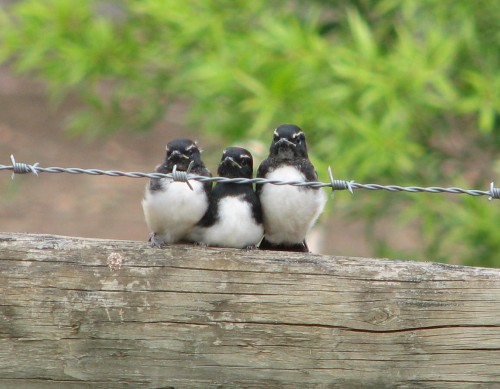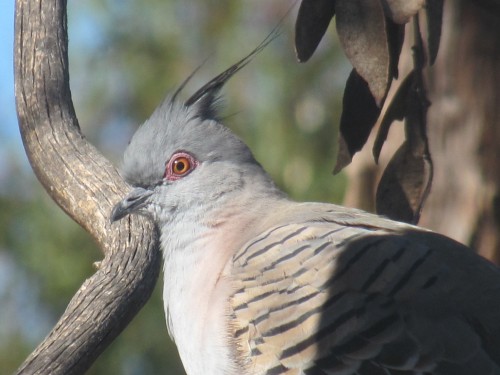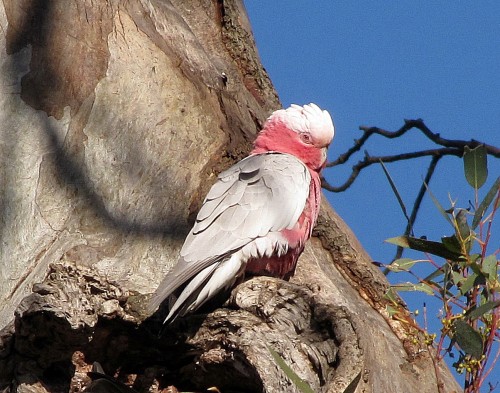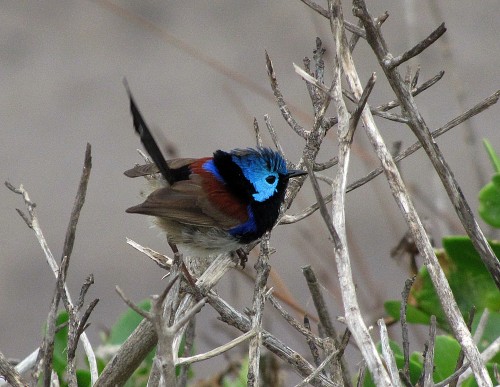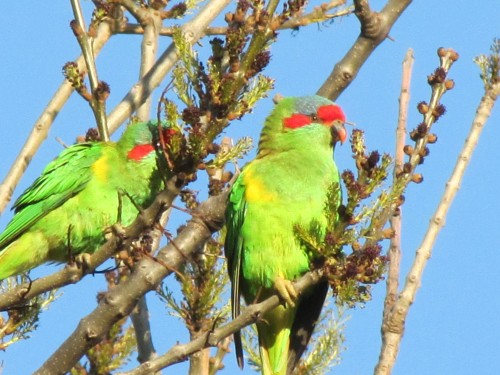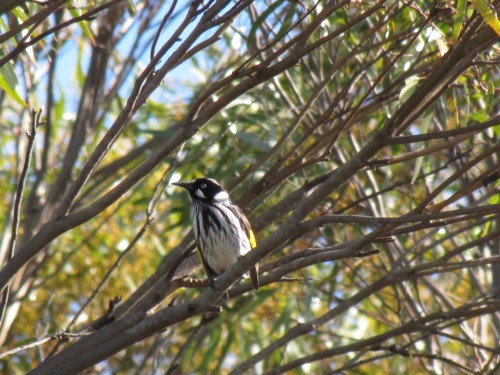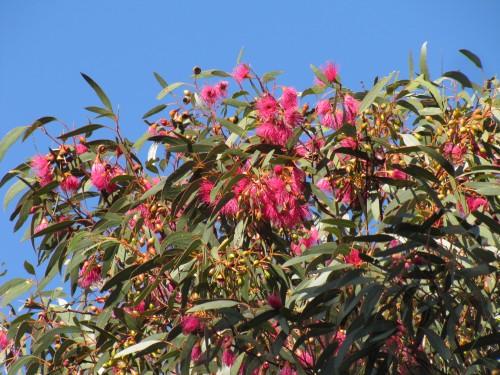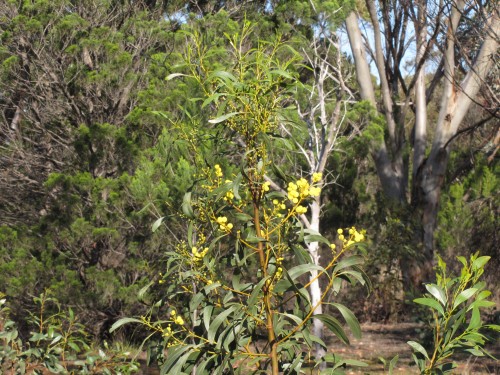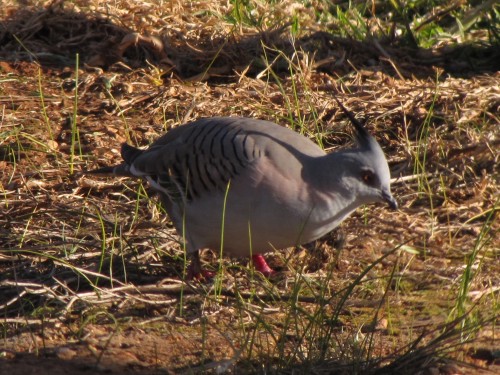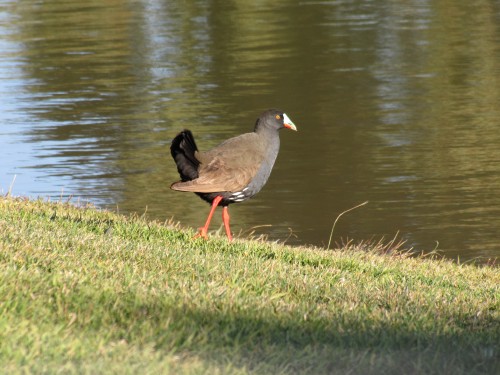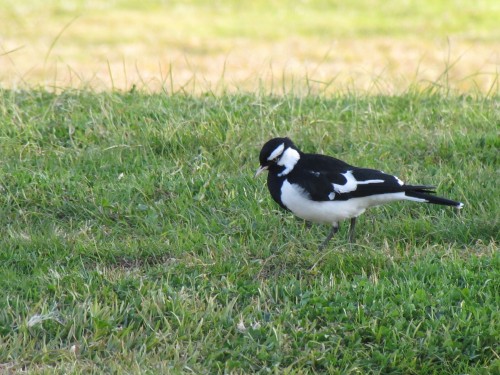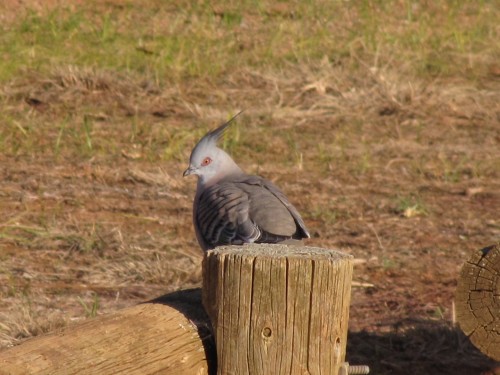It’s nesting time again
It’s that time of year again in Australia – spring nesting season.
Birds everywhere are making nests, sitting on eggs in nests or feeding young just out of the nest. In southern Australia – the region I am most familiar with – the “spring” nesting season stretches from the winter months of July and August, through the entire season of spring (September – November) and even well into summer (December – January).
Having confused all of my overseas readers I should explain three things:
- Most of the breeding occurs in the spring months.
- Some species – like our honeyeaters – will nest multiple times, raising 2 or more broods a season.
- Some species will even raise as many as five broods over a six month period.
Being late September nesting is in full swing here on our 5 acre (2 hectare) property in Murray Bridge, South Australia. The following is a quick annotated list of those species I have observed in the breeding mode in recent weeks:
Willie Wagtail: our resident birds have been very quiet and I suspected that they had a nest somewhere but I only found it yesterday. It contained two eggs. The photo above shows a fluffy family of Willie Wagtails just out of the nest a few years ago.
New Holland Honeyeater: last week I saw two parent birds fussing over and feeding two fledglings just out of the nest and barely able to flutter, let alone fly.
Red Wattlebird: I saw one bird sitting on a nest high in one of our trees but haven’t checked it in recent days. Other wattlebirds in our garden are being bossier than usual, so I guess that there are young around somewhere.
House Sparrow (introduced species): they always seem to be mating and nesting, so nothing unusual there.
Common Starling (introduced): the resident dozen or so birds all seem to have taken up occupation of a number of tree hollows in our mallee scrub, but I haven’t yet heard the persistent calls of the nestlings begging to be fed.
Mallee Ringneck parrots: our resident birds were feeding young a month or so ago, and I have seen them constantly investigating a tree hollow. Earlier this week we saw two of them mating, so the next brood could be on the way soon.
Cuckoos: I haven’t seen any cuckoos yet this season but I have heard Horsfield’s Bronze-cuckoos calling several times, so they could possibly be nesting too.
Galah: I’m not sure what our Galahs are doing. They come to a hollow in an old growth mallee tree near our clothes line and enter the hollow every day but nothing else seems to be happening. This has happened now for several years so I will just have to keep an eye on proceedings.
Australian Magpie: this is a really puzzling one. The resident magpies showed all the right activities a few months ago when they defended their territory but since then everything has gone quiet. We daily see several birds feeding around the garden and in the paddock, but I have yet to locate a nest. Very strange.
I have highlighted just 9 species in this article. Over the last 30 years I have observed many more species either breeding, or feeding young, on our property. I am quite confident that there would be other species currently nesting somewhere here, possibly including:
- Grey Shrike-thrush
- Common Blackbird (introduced)
- Spotted Turtledove (introduced)
- Crested Pigeon
- Yellow-rumped Thornbill
- Weebill
- Spotted Pardalote
- Striated Pardalote
- Mistletoebird
- White-plumed Honeyeater
- Spiny-cheeked Honeyeater
- Singing Honeyeater
- Little Raven
- Pacific Black Duck (they bring the ducklings to our swimming pool!
- Superb Fairy-wren
- Australian Magpie-lark
- Grey Butcherbird
Further reading:
Click on the following article headings to read about successful breeding attempts in past years:
- We have baby Willie Wagtails
- New Holland Honeyeater nest
- Red wattlebirds with young
- House Sparrows eating berries
- Very Common Starlings – nesting
- Mallee Ringnecks nesting
- Horsfield’s Bronze-cuckoo
- Possible Galah nesting attempt
- Baby Magpie – this is the most popular article on this site with nearly 500 reader comments.
Happy 10th Birthday to Trevor’s Birding
Happy Birthday to Trevor’s Birding.
10 years old today.
Goodness, how the years have flown since my very first post on this site. That was actually on a different platform and has been updated several times over the years.
A few statistics
- A total of 1668 articles about birds and birding
- Well over 5300 comments from my readers
- Several thousand photos shown
- Visitors from over 200 countries and territories
- Over a million pageviews from well over half a million visitors
Travels
Wherever I travel I take my camera, binoculars, notebook and field guide and fit in times of birding (bird watching) and bird photography whenever I can. On many occasions I also go out and about near my home for the deliberate purpose of birding. On my return home I then enjoy writing on this site about the birds I have seen and sharing the best of my photos. Some of these travels take me to other states in Australia as well, especially when we visit family in Sydney, and friends in other places.
Archives
Some of my readers may not be aware of the many hundreds of articles in my archives – 1668 articles to be precise – and growing every few days with new articles. These can be accessed via the button at the top of each page and range from the most recent to the very first article. Here is a treasure trove of writing about birds.
Contents
Another way of accessing articles on specific areas of interest is via the Contents on the side bar, including
- How to be a birder
- Glossary of Bird Words – to help my readers understand any jargon used here (and it needs some editing – as well as be completed)
- Favourite Birding Spots – some of my favourite places to go birding (and it needs some serious updating!)
- Great birding moments – those special times when I saw a special bird, or got a lovely photo
Categories and search
Another way of searching for specific information on this site it to use the search facility (in the top right hand corner of each page). Just type in what you are looking for – you might be surprised what comes up. The categories section on the sidebar is another area where you can search for articles on a particular species or topic. If all that doesn’t work, try the contact form – also at the top of each page. Send your questions to me via email and I will reply as soon as I can, noting that there will be a delay if I am busy out birding and away from my computer.
Comments
Every article has a comments section and I would love to have many more. The 5300 comments so far are just the beginning. Just remember that they are moderated, and I reserve the right not to accept, or delete, or even edit comments, so keep them civil and in good taste. Children often read the articles here.
Photos
Over the years I have shared many photos here, with many more to come. Today, however, I decided to share a few of my favourite ones (see below).
Enjoy.
And keep coming back for more.
Good birding.
Trevor
Further reading:
- My first blog post
- Archives – you can access the complete list of articles on this site here or via the button at the top.
Birding at Mannum South Australia
Over recent posts here I have written about a trip we went on after a visit to Adelaide for a medical appointment. We travelled home via Gorge Road, Gumeracha, Birdwood and on to Mannum for lunch. Mannum is about a half hour drive north of our home in Murray Bridge and is also situated on the banks of the Murray River.
After buying our lunch at the local bakery – excellent food, by the way – we drove the short distance to the other end of town, stopping at Lions Park on the wetlands area next to the local caravan park. This is a lagoon which is usually full of water from the adjacent main part of the river. On most occasions I find that this is quite a suitable birding area with a good variety of both water-birds and local bush birds.
As I wrote in my last post I had forgotten to bring my camera with on this trip, something I rarely forget. Consequently I had to be content with sightings using my binoculars and not get too excited about potential photos. It wasn’t long before I was really regretting my oversight regarding the camera.
As we ate our delicious lunch a colourful male and female Superb Fairy-wren came hopping across the grass only a few metres in front of our car. They would have provided me with some wonderful shots, but that was not to be.
A few moments later – as if to taunt me even further – an Australian Reedwarbler came out of the reeds nearby and it also began hopping around on the grass only metres in front of the car. Over the years I have struggled to get good shots of this bird. One hears them wherever there are reeds but one only ever catches glimpses of them scurrying from one patch to another. They don’t seem to want to stop and pose in full view and in good light so my camera can do its work. To see one hopping around in plain view was just taunting me. Never mind – I will return!
All in all it was a quite productive hour of birding. Here is a list of my sightings:
- Australian Reedwarbler
- Superb Fairy-wren
- Crested Pigeon
- House Sparrow
- Peaceful Dove
- Galah
- Purple Swamphen
- Eurasian Coot
- Little Black Cormorant
- White-plumed Honeyeater
- New Holland Honeyeater
- Masked Lapwing
- Whistling Kite
- Australian Pelican
- Silver Gull
- Noisy Miner
- Pacific Black Duck
- Grey teal
- Red Wattlebird
- Australian Magpie
- Little Corella
- Welcome Swallow
- Little Grassbird
- Caspian Tern
- Little Raven
- Magpie Lark
- Willie Wagtail
- Striated Pardalote
- Black-tailed Native Hen
- Red-rumped Parrot
I must go back again some time soon – and try to remember my camera.
Good birding
Trevor
Birding at Browns Road Monarto
This afternoon my wife and I took a detour coming home from Mt Barker in the Adelaide Hills. We had been there for a appointment, after which we had a relaxing lunch in one of the local cafes. Instead of taking the South-Eastern Freeway home to Murray Bridge we took the old Princes Highway route. It is a longer, more circuitous route but far more interesting.
Just past Callington we turned off into Browns Road near Monarto. We stopped at a spot where we could park the car safely before going on a short walk through the scrub. The sign on the gate says “Monarto Woodlands” but local birders usually refer to this area as Browns Road.
The scrub here is a confusing mixture of plant species. While there are some species common to the surrounding region, many of the trees and shrubs are introduced from other parts of Australia. A quick glance shows many Western Australian species, for example. This has come about due to extensive planting back in the 1980s when this area was designated as a satellite city to Adelaide. While a large area of farming land was purchased by the then state government, and the city was planned, no building ever occurred and much of the land has been returned to productive agricultural use. The only exception has been the establishment nearby of Monarto Open Range Zoo, part of Adelaide Zoo (and well worth a visit too, I might add).
We didn’t have all that much time on our visit this afternoon and my back and hips were being quite a pain. In the few minutes we were there I managed to record the following species:
- White-winged Chough
- Singing Honeyeater
- Red wattlebird
- New Holland Honeyeater (pictured above)
- White-browed Babbler
- Peaceful Dove
- Crested Pigeon
- Grey Fantail
- Willie Wagtail
- Yellow Thornbill
- Spiny-cheeked Honeyeater
- Silvereye
- Grey Shrike-thrush
- Common Starling
- Adelaide Rosella
- Australian Magpie (white backed)
- Weebill
While this is not a great list it is not bad for about ten minutes of birding. In recent weeks many other South Australian birders have visited this area and have reported far more species. I must visit more often, seeing it is about a 20 minute drive from home.
Some of the plants flowering are shown in the photos below.
Further reading:
Random bird photos at Peterborough
Over recent days I have posted a few photos of some birds taken on a recent visit to Peterborough. On this visit we were visiting relatives for a few days. Peterborough is in the mid-north of South Australia. One of the spots I always like to check out is Victoria Park near the swimming pool and caravan park.
Many years ago the local council made a very pleasant park, including lawned picnic areas, barbecue facilities and an artificial lake. This water attracts quite a range of water-birds as well as providing drinking water for many of the local bush species such as pigeons, honeyeaters, ravens and magpies.
Today I thought I would share some random photos taken on this most recent visit.
